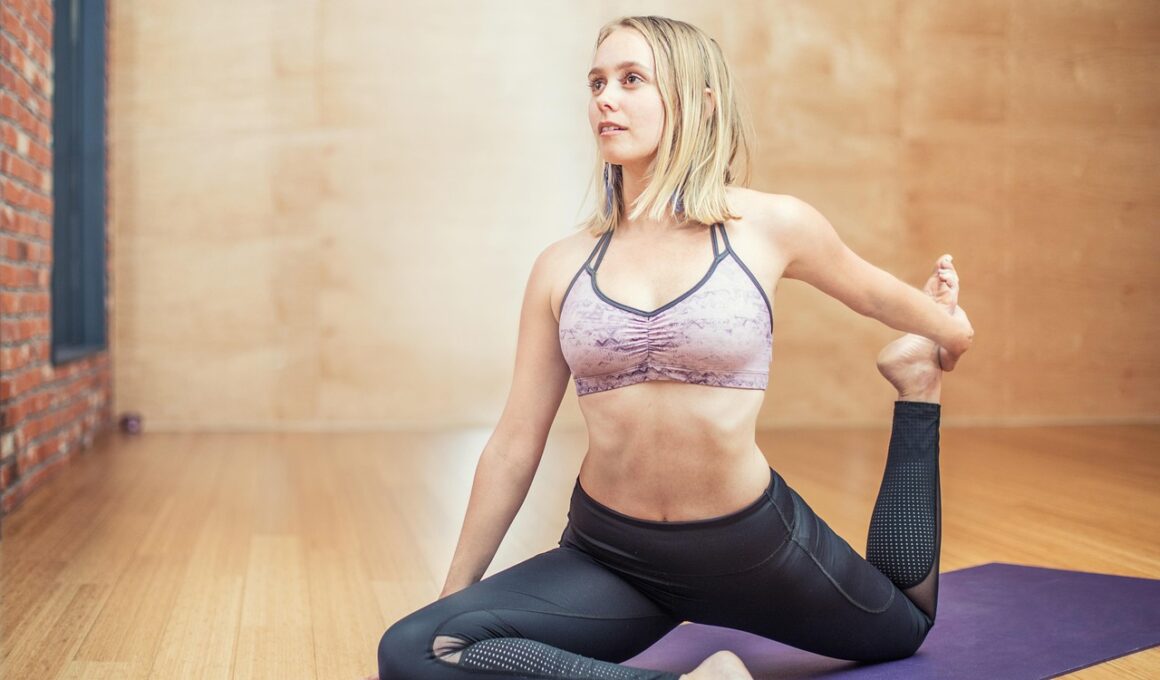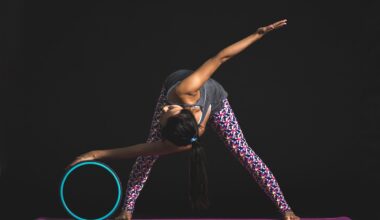Resistance Bands Yoga for Beginners: Essential Poses and Tips
Resistance bands yoga is an effective workout for beginners looking to enhance their fitness routine. Integrating these bands into traditional yoga poses helps to improve strength, flexibility, and stability. Not only does this combination provide resistance training, but it also adds a new dimension to your yoga practice. When using resistance bands, it’s essential to ensure proper form and control throughout each movement. Begin with simple poses and gradually progress to more advanced variations. This method allows you to safely build strength, accommodating your physical capabilities. It’s crucial to select the appropriate tension of the band for your level. Lighter bands are recommended for beginners, as they provide less resistance. As you become accustomed to the exercises, you can transition to more challenging bands. Additionally, remember to focus on your breathing while practicing yoga with resistance bands. Proper breathing enhances your muscular endurance and allows you to maintain posture. Finally, warming up adequately before starting is vital to avoid injuries. Choose familiar yoga poses to start with, gradually introducing bands into your sessions for a balanced practice.
Benefits of Resistance Bands in Yoga
Incorporating resistance bands into your yoga practice offers numerous benefits that can enhance your overall experience. First, these bands provide resistance, helping to build muscle strength while maintaining flexibility. This unique combination is essential for beginners who may struggle with standard yoga poses. Furthermore, resistance bands allow for greater variety in workouts, enabling you to target specific muscle groups effectively. As a result, you can tailor your exercises according to your personal fitness goals. Another benefit is the ability of resistance bands to assist in stretching. Many beginners find themselves unable to achieve the full depth of particular yoga poses. Using bands can support these stretches, ultimately improving suppleness over time. Resistance bands also help with proper posture, enabling you to maintain correct form throughout each pose. This support reduces the risk of injury and fosters a more rewarding practice. Moreover, they are highly convenient and portable, allowing you to perform workouts anywhere — be it at home or during travel. If you’re seeking to enhance your yoga routine, these bands are a simple yet effective addition to your practice.
To successfully integrate resistance bands into your yoga practice, start with a few fundamental poses. These foundational poses provide a stable introduction to the added resistance. One excellent pose to begin with is the Warrior I. In this position, you will step into a lunge, placing the band under your front foot. Grasp the band, allowing it to offer support while you stretch upward. Ensure you’re mindful of your body alignment at all times. Another essential pose is the Downward Dog. Place the band around your mid-foot, pulling it for added resistance to engage your core. Gradually increase the resistance as you grow stronger. Next, try the Seated Forward Bend. The band should be looped around your feet and you can hold it while achieving the stretch. With consistent practice and attention to your form, you can enhance both strength and flexibility. Incorporate these poses into your routine for about 10 to 15 minutes. Allocate time to focus on breathing techniques, enabling mindfulness in your practice. Resist the urge to rush through these poses; instead, embrace the journey as you progress in strength.
Essential Tips for Beginners
For those venturing into resistance band yoga, there are several essential tips to ensure a safe and enjoyable experience. The first tip is to select the right resistance band that matches your fitness level. As a beginner, a light tension band will suffice. Gradually advance to stronger bands as you develop your strength. Another crucial tip is to pay attention to your posture while practicing. Poor alignment can lead to injuries, so focus on correct form. Engaging your core and aligning your spine is key to maintaining balance. Additionally, consistency is vital with any fitness program. Aim for regular practice, ideally two to three times each week. This approach not only helps to carve out muscle memory but also develops a deeper mind-body connection. Remember to warm up before your practice to prevent strains. Stretching beforehand prepares your muscles and joints for exercise. Lastly, embrace progress over perfection. Every individual’s journey is unique, and perfection should never be the goal. Celebrate small victories while continually pushing forward with your resistance bands yoga practice.
As you become more comfortable with resistance bands yoga, consider increasing the complexity of your poses. One advanced pose is the Half Moon Pose, which integrates the band for balance support. Stand on one leg and extend the other leg behind while using the band to stabilize your body. Begin by creating a sense of minimal tension for balance, then gradually increase it for strength. The Plank Pose can also benefit greatly from the addition of bands. Create resistance by pulling the band through one arm while holding your plank. This enhances upper body engagement and helps develop core stability while maintaining balance. Another valuable addition is the Bird Dog Pose, where you can use resistance bands to strengthen your lower back and core while targeting stabilization. Attach the band to your foot and the opposite hand for maximum engagement. Slowly increase tension on the band as you master these poses. Challenge yourself by incorporating more dynamic flows, transitioning between upper and lower body poses smoothly. This will enhance overall fitness and can lead to more significant strength gains over time.
Common Mistakes to Avoid
As a beginner in resistance bands yoga, there are common mistakes to be mindful of that could affect your practice. One frequent error is selecting a band with tension that is too difficult to manage. Starting with too much resistance can lead to improper form and potential injuries. It is essential to choose a band that allows comfortable movement. Another mistake involves rushing through poses without focusing on fluid transitions. Each pose requires attention to detail and awareness, which fosters an effective workout. Remember, it’s not about speed, but rather the quality of each movement. Additionally, neglecting to warm up appropriately is a mistake that can lead to injuries. Dedicating time to prepare the body is crucial for performance. Overextending your limits and forcing poses is another common pitfall. Listen to your body and avoid pushing excessively into a stretch or pose. Finally, disregarding breathing techniques can limit the benefits of yoga practice. Incorporating breath awareness enhances concentration and supports muscle relaxation. Being aware of these mistakes helps you cultivate a safer, more productive experience in resistance bands yoga.
In summary, integrating resistance bands into your yoga practice is a rewarding way to boost your fitness journey. This method offers numerous benefits for beginners, including strength building, enhanced flexibility, and improved balance. Remember to start with fundamental poses while gradually introducing resistance bands as you become more comfortable. Maintaining proper posture is imperative throughout your workouts, so pay close attention to your alignment. Additionally, consistency and embracing progress are fundamental to ensuring your success. Celebrate each small victory on the path toward your fitness goals and remain patient with yourself. Explore the various poses and enjoy the benefits of increased strength and flexibility they provide. Awareness of common mistakes will help you avoid pitfalls and stay aligned with your intentions. Regular practice will empower you to harness your body’s potential through resistance bands yoga. Whether practicing at home or in classes, focus on mindfulness and well-being during your sessions. Allow this amalgamation of resistance bands and yoga to aid you in achieving a more profound understanding of your strength, balance, and flexibility through loving, compassionate practice.


